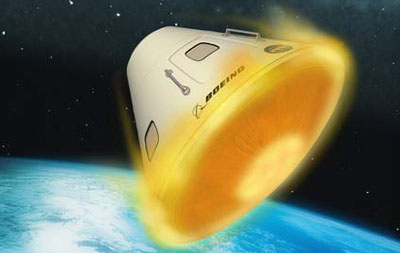|
|
 The Columbia accident put greater emphasis on the Orbital Space Plane, but also greater scrutiny given the high costs to develop a vehicle that, like this Boeing concept above, may be nothing more than a simple capsule. (credit: Boeing) |
The lessons we (should have) learned in 2003
by Jeff Foust
Monday, January 5, 2004
It’s customary around New Years for publications to trot out their year-in-review stories, summarizing the events of the past year in several hundred words and perhaps a few photos. It’s a natural thing to do: people are usually reflective this time of year, wanting to take one final look back at the past year before moving ahead with the new one. (They’re also useful for publications from a practical standpoint: they can fill a new hole during a time of year that is relatively slow, and they can be largely written in advance, allowing staffers to take the holidays off.)
Yet, in many respects, these year-end reviews are relatively shallow. Do we really need to be reminded of what took place in the past year? After all, unless you were trapped in a cave or on a desert isle for much of the year, you’re already well aware of what took place. What’s often missing is more critical thought about those events: why are some more important than others, and how will the past year’s events shape the coming year and beyond? That’s more important in the long run than a simple recitation or ranking of the major events of the year.
This article, therefore, won’t be a list of the top events of the year but instead the top lessons learned from those events. Some of these conclusions should seem obvious, while others may not. (That’s why the words “should have” in the title are in parentheses; not everyone will agree with these lessons, and some will simply be impervious to their logic.). It wouldn’t be a Near Year’s article without some resolutions and predictions, which we’ve thrown in along with the lessons.
Lesson 1: Space transportation is broken (part 1)
The biggest space event of 2003, understandably, was the tragic loss of the space shuttle Columbia and its seven-person crew during reentry on February 1. The event had major repercussions both within NASA and in wider circles. The accident brought the assembly of the International Space Station to a halt, and forced the station to fall back to a two-person caretaker crew supplied exclusively by Russian Progress and Soyuz spacecraft. The seven-month investigation into the accident cast an unwelcome spotlight onto not just the shuttle itself, but institutional problems with NASA itself—the so-called “culture” issue. NASA also found itself under sharp scrutiny from a Congress that, indirectly, may have contributed to the accident itself by approving a series of budgets during the last decade that squeezed money out of the shuttle program.
One of the biggest outcomes of the accident, though, was the realization of how fragile the shuttle and NASA’s human spaceflight program are in general. Prior to the Columbia accident, NASA had made shuttle operations look relatively routine. With no successor on the drawing boards, it seems likely that the shuttle would continue flying well into the next decade, perhaps out to 2020. Now that seems far less likely. While the agency continues to look at life-extension efforts for the shuttle, the Columbia accident and investigation made it clear that the shuttle has been, and always will be, an experimental, and not an operational, vehicle, one that should be retired at the earliest possible opportunity. Indeed, one of the recommendations of the Columbia Accident Investigation Board (CAIB) was for NASA to recertify the shuttle if it plans on flying it beyond 2010, a recommendation the CAIB added even though its members believes that it was unlikely the shuttle could indeed pass a recertification.
| One CAIB recommendations was for NASA to recertify the shuttle if it plans on flying it beyond 2010, a recommendation the CAIB added even though its members believes that it was unlikely the shuttle could indeed pass a recertification. |
The shuttle accident put pressure on NASA to develop the Orbital Space Plane (OSP) at a stopgap successor to the shuttle. OSP was born in November 2002 from the ashes of the Space Launch Initiative as both a crew return vehicle (CRV) for the ISS as well as, possibly, a crew transfer vehicle as well. After Columbia NASA made a major push to accelerate the OSP, realizing the uncertain future of the shuttle. However, by the end of the year the future of the program, if not in danger, was under stronger debate than expected. Some in Congress, concerned that the CRV-only version of OSP could cost well over $10 billion even as many designs looked like little more than Apolloesque capsules, wanted to put the brakes on the program until the future direction of the space agency became clearer. OSP’s funding for 2004 looks assured now, but even the existence of such a debate underscores how unsettled NASA’s human spaceflight program is.
The solution to this conundrum will not come easily. Some have argued for a harsh solution: canceling the shuttle outright, as the Los Angeles Times suggested in a recent editorial. However, that cure is worse than the disease. It would likely also spell the end of the International Space Station, or at least the assembly of it, and further alienate the US from its international partners. It’s unlikely that such an extreme measure would win much support from the Bush Administration or Congress, who will instead opt for a more moderate path of safely returning the shuttle to flight, possibly by late this year but more realistically in early 2005. Look for Congress to continue to put pressure on NASA to contain the costs of OSP as well.
Related articles:
page 2: lesson 2: space transportation is broken (part 2) >>
|
|
